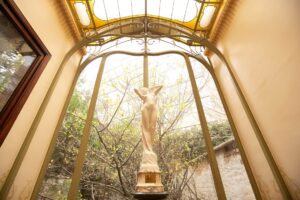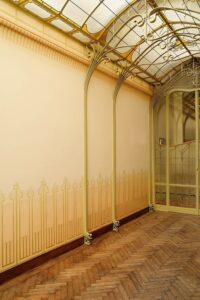When I bought Hôtel Frison five years ago, I had no idea who Victor Horta was. It’s embarrassing to admit, but it’s true. I did not know anything about the visionary who is synonymous with Art Nouveau, the architect who inspired a generation of builders and decorators, and the man who designed this emblematic heritage house.
Now, five years on, I know the man a little better. I have written a book on my house, and I’m working on my second, exploring the links between India and Art Nouveau – while doing my Master’s degree in architecture and restoring the house.
As for Hôtel Frison, it was love at first sight, even then. And I have since come to appreciate Horta as a creative genius who drew from cultures and environments far beyond the traditions of his time.
The Hôtel Frison is hidden in plain sight, on Rue Lebeau, which runs from the Sablon down towards the lower town. It was built by Horta for his friend Maurice Frison in 1894. It is his only townhouse in the Brussels city centre. By then, the distinctive Art Nouveau style that Horta is known was only two years old, emerging with the Hôtel Tassel, quickly followed by the Maison Autrique and the Hôtel Winssinger.
Frison was a distinguished lawyer, a social and civil reformer, architect of the social welfare structure that would become the CPAS/OCMW, and also the driving force behind project the Brugmann University Hospital, which Horta designed. For his house, he wanted a building that would serve both as his office and home. This double function concept was modern at the time, and the building is an intricate scheme of levels adding up to a total of eight levels from the cellar to the attic. Horta later wrote about the house: “The design, including the expense incurred, was to everyone’s satisfaction, including that of the client’s fiancée.”
Decades of dirt and neglect
That was then. But the Hôtel Frison fell into disrepair some decades ago. When I arrived, it was dirty, neglected and run down. It had been on sale for over 18 years but had not been lived in for over 15 years.
Yet I found myself almost magically drawn to it. When the owner, an old lady, opened the front door to me, I had a deep feeling of arriving home – or at my parents’ or grandparents’ home in India – like I was completing a circle of my life. I felt the house calling to me: “Take care of me!” And that was the pact I made: “I will take care of you.” The house is my second baby. after my seven-year-old daughter.
I'm just the fourth owner in the house’s 128-year history. I soon realized that it would take a monumental effort to restore it. The first six months was just spent cleaning the place. From the outside, it doesn't show how deep it goes, but there is a total of 1,200 square metres. There are around 12 layers of paint to scrape off, which adds up to hundreds of kilos, a Herculean task.
But the effort has been worth it. The stripping of the paint has uncovered the past, revealing warm frescoes depicting tendrils and natural curves. For the first time in generations, we can see the thought processes, artistry, techniques and human creativity that went into crafting the house, both inside and out.
As the frescoes are painstakingly restored from oblivion and neglect, so too the precious exotic woods and unique metal works are revived, the scattered customised furniture traced, returned and restored. The work is still not complete, but the original glories are already emerging, giving the house a new lease of life, at least as rich and compelling as its first.
And what a house! When you open the front door, you face an imposing marble staircase, flanked by the metal equivalents of a guard of honour in the iron handrails. These bannisters in the entrance hall take his signature curves to a new level, making it appear like a woman arching her back and arms up the stairway.
At the back is the winter garden, which is an extraordinary glass-roofed conservatory designed with almost impossible twists and floral motifs, like an organic greenhouse. That’s not to mention the stairwells, the offset kitchen, dining room and living rooms.
The original décor is emerging too. From the bronze door handles to the crémones of the windows, from the ornate panelling and the terrazzo floor to the sliding doors that disappear into the walls. Every detail is meticulously planned.
No wonder this house was seized and occupied by the Gestapo during Second World War – although they covered the walls with white paint, hiding the frescoed patterns. Further alterations were made in 1955 when the façade that opened onto the lawyer's office was altered with the installation of a business. Later, when Art Nouveau fell out of fashion, the house was considered a kitsch embarrassment. I was astonished that the previous owners did not want it to be part of the UNESCO World Heritage listing for Horta.
An Indian connection?
I work in the jewellery sector maker – I’m not an art historian or an academic – and this house is a diamond.
It also resonates with my Indian heritage. India is almost never mentioned as an influence on Horta. However, it struck me immediately: the shutters, the frescoes, the ottoman shape of the winter garden doors, the plant decorations, the cobra patterns, the colours, the red and the mustard that I discovered later while stripping the walls: it all reminds me of Rajasthan.
Horta never went to India, but in a way, India came to him. Indian culture was being brought to Britain in the late 19th century, influencing arts and crafts, as you see with the designs of William Morris. For Indians, the influence is obvious. It's in the vegetation, the leaves, the flora and fauna, the forms, the spiritual symbols, and the colours. It's always been there, but nobody connected the dots.
It’s this connection that made me decide to set up the Foundation Frison Horta in the house. It is a multidisciplinary centre, a living museum that celebrates East-West culture, with concerts and exhibitions like our recent photography show on maharani and the current display by Spanish photographer Bernardo Aja.
For Indians, a house is spiritual. It's part of the family: we don't buy houses as an investment. We buy because it's part of the legacy. It's passed on to the next generation. And why I feel this house, a sleeping beauty, was waiting for me. It’s a legacy that my daughter will carry on, as we share this beautiful heritage that unites all cultures.






